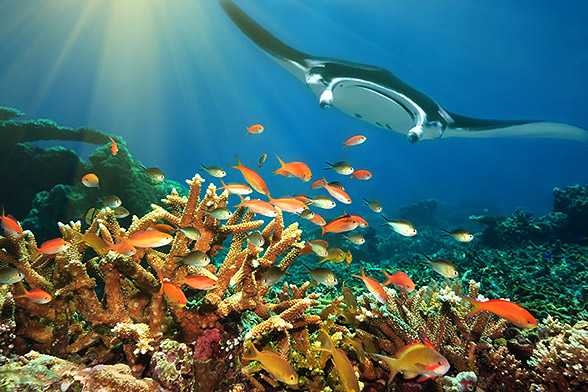Manta Rays Are Driven to the Brink of Extinction

Seeing manta rays in the wild is perhaps one of the favourite experiences of many divers, and thousands of tourists flock annually for the incredible and truly memorable experience of seeing these gentle giants glide through the water. It’s shocking then, that mantas are now being driven to extinction – by the actions of humans themselves. Global warming, toxic chemicals and overfishing are all to blame – and have rapidly reduced the numbers of manta species globally, to dangerously low levels.
Environmental factors including the destruction of coral reefs and global warming have caused havoc with natural feeding and migratory patterns, leaving them at risk to serious harm. Many species of manta regularly visit reefs to feed and be cleaned, and organisms at the reefs make up a primary food source for them. The loss of the reefs heavily impacts the ability of manta to support themselves and thrive.
As well as the reduction of food sources, global warming has also had a serious impact on the safety of manta rays. In some affected areas, global warming has seen smaller bodies of water such as lakes, swamps and lagoons dry up dramatically. Mantas which used to make these their home have died out as they had too little water to move around in. The most serious threat to manta rays comes from people themselves – particularly from by catching and over fishing. The increasing use of industrial fishing methods with large longline and gill nets, often used to catch tuna, also result in manta rays becoming entangled alongside them. Unable to swim back out, mantas become increasingly tangled – and die due to a lack of oxygen supply over their gills.
More than by catching however, is the threat from deliberate manta ray fishing. An increase in popularity in manta ray gills as an ingredient for traditional Chinese medicines have seen vast numbers of manta ray being captured. With supposed benefits including improving fertility, curing cancer and other serious ailments, the manta ray gill rakes are valued up to $500 per kilogram, and many fishermen supplying Asian markets see this as a lucrative opportunity. While traditional practitioners do not believe this is an effective or even a legitimate remedy, the market has nevertheless grown enormously. Over 61,000 kg of gill rakes are now sold annually, with an estimated value of over $11 million. These activities have seen manta ray numbers drop dangerously close to extinction levels – a 2009 study showed that 32% of open-shark and ray species were on the brink of extinction.
Manta Ray in captivity in Okinawa, Japan
Paradoxically, the greatest economic and environmental value of manta rays comes not from consuming them, but in supporting them instead. A popular tourist attraction for divers across the world, manta rays attract thousands of visitors on a regular basis – and the global value of tourism generated by manta rays is estimated to exceed $100 million. With increased calls for stricter measures of protection and regulation of fisheries, only timely and determined action can prevent the loss of these graceful and captivating creatures.